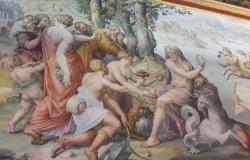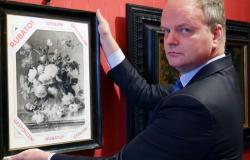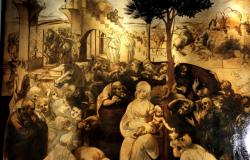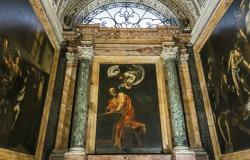Dismissing theories of self-portraiture, dental problems, mourning and the like, a French art expert has found evidence for the idea that the Mona Lisa had just given birth - and hence her enigmatic smile .
Bruno Mottin of the French Museums' Center for Research and Restoration has examined 3D images of Leonardo Da Vinci's iconic painting produced by laser and infrared scans .
The images, taken by a team of Canadian scientists who were given rare access to the picture at its home in Paris' Louvre Museum, revealed that the woman who sat for the portrait was wearing a fine gauze veil on her dress .
"This type of gauzy covering was typically worn in 16th-century Italy by pregnant women or new mothers," said Mottin at a Tuesday press conference in Ottawa on the Canadian team's findings .
"We can now affirm that Leonardo's painting was commissioned to celebrate the birth of the second child of La Gioconda," Mottin said, arguing that this explained the sitter's self-satisfied smile .
"This also helps us date the painting with greater precision to 1503," he added .
Most modern scholars believe that the Mona Lisa sitter is Lisa del Giocondo, who was the third wife of a rich Florentine merchant called Francesco di Bartolomeo de Zanobi del Giocondo .
The couple were married in 1495 when the bride was 16 and the groom 35 .
It has frequently been suggested that del Giocondo commissioned Leonardo to paint his Mona Lisa (mona is the standard Italian contraction for madonna, or "my lady,") to mark his wife's pregnancy or the birth of their second child in December 1502. Mottin said her gauzy veil had become invisible to the naked eye because the picture's upper layers of varnish and paint had darkened over the years and obscured it .
The images taken by the National Research Council of Canada (NRC) allowed the details beneath the upper layers to come through, including evidence that Leonardo originally posed La Gioconda with her hair up under a cap and a few escaping curls .
Mottin noted that the final version, in which Mona Lisa's hair hangs loosely about her shoulders, had always surprised art experts because "only very young women or those of ill repute wore their hair that way" .
He said Leonardo had also changed his mind about the position of her hands. Originally, he depicted her gripping her chair as if she were about to get up whereas the final painting shows one hand placed relaxedly over the other .
The scans, which used a resolution ten times finer than a human hair, were the most high-tech examinations ever to be made of the Mona Lisa .
They showed that the painting was in good shape apart from some warping to the wooden panel on which it is painted and a 12-centimetre crack at the top dating from the 18th-19th century .
"Even though there are some small cracks, the paint layer remains well attached to its support. There are no signs of detachment which is excellent news for a 500-year-old painting," the NRC said .
It said there was no risk of deterioration if the painting continued to be kept in good storage conditions .
MYSTERY LINGERS But one puzzle the experts were unable to crack was the secret to the smoky technique or 'sfumato' which Leonardo used to such effect on the Mona Lisa .
Although they found that it was achieved by mixing oil, varnish and a small amount of pigment and then applying this mixture layer after layer to the poplar panel, they were unable to tell what kind of tiny strokes he used or how many layers he applied to give the portrait its hazy edge .
Mottin said that the mystery of how Leonardo painted the world's most famous portrait remained "unsolved" .
"That is a real challenge," he said. Although pregnancy or childbirth have frequently been put forward in the past as explanations for Mona Lisa's cryptic smile, other theories have not been lacking - some less plausible than others .
Some have argued that the painting is a self-protrait of the artist, or one of his favourite male lovers in disguise, citing the fact that Da Vinci never actually relinquished the painting and kept it with him up until his death in Amboise, France in 1519 .
The most curious theories have been provided by medical experts-cum-art lovers .
One group of medical researchers has maintained that the sitter's mouth is so firmly shut because she was undergoing mercury treatment for syphilis which turned her teeth black .
An American dentist has claimed that the tight-lipped expression was typical of people who have lost their front teeth, while a Danish doctor was convinced she suffered from congenital palsy which affected the left side of her face and this is why her hands are overly large .
A French surgeon has also put forth his view that she was semi-paralysed, perhaps as the result of a stroke, and that this explained why one hand looks relaxed and the other tense .
Leading American feminist Camille Paglia simply concluded that the cool, appraising smile showed that "what Mona Lisa is ultimately saying is that males are unnecessary" .



















